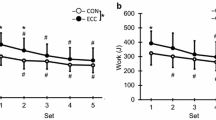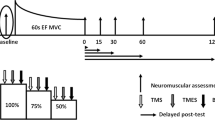Abstract
This study investigated the changes in muscular activity and tissue oxygenation while lifting and lowering a load of 20, 40, 60 or 80 % of one repetition maximum (1RM) with elbow flexor muscles until failure. The surface electromyogram (EMG) was recorded in biceps brachii (BB), brachioradialis (BRD) and triceps brachii (TB). For BB, a tissue oxygenation index (TOI) and a normalized total hemoglobin index (nTHI) were recorded by near-infrared spectroscopy. The number of repetitions decreased with the increase in load (P < 0.001), and the four loading conditions induced a decrease in MVC force immediately after failure (P < 0.001). The average of rectified EMG amplitude (aEMG) of elbow flexors increased for all loads during muscle shortening (SHO) and lengthening (LEN) phases of the movement (P < 0.05), except for the 80 % load during LEN phase. At failure, the aEMG was greater during the SHO than the LEN phase (P < 0.05), except for the 20 % load. TOI decreased for all loads and phases (P < 0.05) but less (P < 0.01) for the 20 % than 60 and 80 % loads (P < 0.01), and for LEN compared with SHO phase. At failure, TOI was negatively associated with aEMG during the SHO (r 2 = 0.99) and LEN (r 2 = 0.82) phases, while TOI and aEMG were positively associated with load magnitude (r 2 > 0.90) in both movement phases. This study emphasizes the influence of load magnitude and movement phase (SHO and LEN) on neuromuscular and oxydative adjustments during movements that involve lifting and lowering a load until failure.






Similar content being viewed by others
References
Aagaard P, Simonsen EB, Andersen JL, Magnusson SP, Halkjær-Kristensen J, Dyhre-Poulsen P (2000) Neural inhibition during maximal eccentric and concentric quadriceps contraction: effects of resistance training. J Appl Physiol 89:2249–2257
Abbruzzese G, Morena M, Spadavecchia L, Schieppati M (1994) Response of arm flexor muscles to magnetic and electrical brain stimulation during shortening and lengthening tasks in man. J Physiol 481:499–507
Adreani CM, Kaufman MP (1998) Effect of arterial occlusion on responses of group III and IV afferents to dynamic exercise. J Appl Physiol 84:1827–1833
Allen DG, Lamb GD, Westerblad H (2008) Skeletal muscle fatigue: cellular mechanisms. Physiol Rev 88:287–332
Barnes WS (1980) The relationship between maximum isometric strength and intramuscular circulatory occlusion. Ergonomics 23:351–357
Baudry S, Klass M, Pasquet B, Duchateau J (2007) Age-related fatigability of the ankle dorsiflexor muscles during concentric and eccentric contractions. Eur J Appl Physiol 100:515–525
Bigland-Ritchie BR, Woods JJ (1976) Integrated electromyogram and oxygen uptake during positive and negative work. J Physiol 260:267–277
Bigland-Ritchie BR, Dawson NJ, Johansson RS, Lippold OC (1986) Reflex origin for the slowing of motorneurone firing rates in fatigue of human voluntary contractions. J Physiol 379:451–459
Booghs C, Baudry S, Enoka RM, Duchateau J (2012) Influence of neural adjustments and muscle oxygenation on task failure during sustained isometric contractions with elbow flexor muscles. Exp Physiol 97:918–929
Carpentier A, Duchateau J, Hainaut K (2001) Motor unit behaviour and contractile changes during fatigue in the human first dorsal interosseus. J Physiol 534:903–912
de Ruiter CJ, Goudsmit JF, Van Tricht JA, de Haan A (2007) The isometric torque at which knee-extensor muscle reoxygenation stops. Med Sci Sports Exerc 39:443–453
de Salles BF, Simão R, Miranda F, NovaesJda S, Lemos A, Willardson JM (2009) Rest interval between sets in strength training. Sports Med 39:765–777
Dideriksen JL, Enoka RM, Farina D (2011) Neuromuscular adjustments that constrain submaximal EMG amplitude at task failure of sustained isometric contractions. J Appl Physiol 111:485–494
Duchateau J, Baudry S (2011) Training adaptation of the neuromuscular system. In: Komi PV (ed) Neuromuscular aspects of sport performance. Wiley-Blackwell, Oxford, pp 216–253
Duchateau J, Enoka RM (2008) Neural control of shortening and lengthening contractions: influence of task constraints. J Physiol 586:5853–5864
Duchateau J, Enoka RM (2011) Human motor unit recordings: origins and insight into the integrated system. Brain Res 1409:42–61
Duchateau J, Balestra C, Carpentier A, Hainaut K (2002) Reflex regulation during sustained and intermittent submaximal contractions in humans. J Physiol 541:959–967
Enoka RM, Baudry S, Rudroff T, Farina D, Klass M, Duchateau J (2011) Unraveling the neurophysiology of muscle fatigue. J Electromyogr Kinesiol 21:208–219
Fang Y, Siemionow V, Sahgal V, Xiong F, Yue GH (2001) Greater movement-related cortical potential during human eccentric versus concentric muscle contractions. J Neurophysiol 86:1764–1772
Felici F, Quaresima V, Fattorini L, Sbriccoli P, Filligoi GC, Ferrari M (2009) Biceps brachii myoelectric and oxygenation changes during static and sinusoidal isometric exercises. J Electromyogr Kinesiol 92:1–11
Ferrari M, Mottola L, Quaresima V (2004) Principles, techniques, and limitations of near infrared spectroscopy. Can J Appl Physiol 29:463–487
Garland SJ, Enoka RM, Serrano LP, Robinson GA (1994) Behavior of motor units in human biceps brachii during a submaximal fatiguing contraction. J Appl Physiol 76:2411–2419
Griffin L, Ivanova T, Garland SJ (2000) Role of limb movement in the modulation of motor unit discharge rate during fatiguing contractions. Exp Brain Res 130:392–400
Harwood B, Choi IH, Rice CL (2012) Reduced motor unit discharge rates of maximal velocity dynamic contractions in response to a submaximal dynamic fatigue protocol. J Appl Physiol 113:1821–1830
Keenan KG, Farina D, Maluf KS, Merletti R, Enoka RM (2005) Influence of amplitude cancellation on the simulated surface electromyogram. J Appl Physiol 98:120–131
Klitzman B, Duling BR (1979) Microvascular hematocrit and red cell flow in resting and contracting striated muscle. Am J Physiol 237:H481–H490
Kukulka CG, Clamann HP (1981) Comparison of the recruitment and discharge properties of motor units in human brachial biceps and adductor pollicis during isometric contractions. Brain Res 219:45–55
Martin PG, Weerakkody N, Gandevia SC, Taylor JL (2008) Group III and IV muscle afferents differentially affect the motor cortex and motoneurones in humans. J Physiol 586:1277–1289
Muthalib M, Lee H, Millet GY, Ferrari M, Nosaka K (2011) Comparaison between maximal lengthening and shortening contractions for biceps brachii muscle oxygenation and hemodynamics. J Appl Physiol 109:710–720
Neyroud D, Maffiuletti NA, Kayser B, Place N (2011) Mechanisms of fatigue and task failure induced by sustained submaximal contractions. Med Sci Sports Exerc 44:1243–1251
Pasquet B, Carpentier A, Duchateau J (2006) Specific modulation of motor unit discharge for a similar change in fascicle length during shortening and lengthening contractions in humans. J Physiol 577:753–765
Place N, Bruton JD, Westerblad H (2008) Mechanisms of fatigue induced by isometric contractions in exercising humans and in isolated mouse single muscle fibres. Proc Aust Physiol Soc 39:115–122
Rudroff T, Jordan K, Enoka JA, Matthews SD, Baudry S, Enoka RM (2010) Discharge of biceps brachii motor unit is modulated by load compliance and forearm posture. Exp Brain Res 202:307–316
Rudroff T, Justice JN, Holmes MR, Matthews SD, Enoka RM (2011) Muscle activity and time to task failure differ with load compliance and target force for elbow flexor muscles. J Appl Physiol 110:125–136
Sadamoto T, Bonde-Petersen F, Suzuki Y (1983) Skeletal muscle tension, flow, pressure, and EMG during sustained isometric contractions in humans. Eur J Appl Physiol Occup Physiol 51:395–408
Sahlin K (1996) Metabolic factors in fatigue. In: Hargreaves M and Spriet L (eds) Exercise metabolism (2nd ed). Champaign, IL: Human Kinetics, pp 163–185
Sale DG, MacDougall JD, Alway SE, Sutton JR (1987) Voluntary strength and muscle characteristics in untrained men and women and male bodybuilders. J Appl Physiol 62:1786–1793
Sawczuk A, Powers RK, Binder MD (1995) Spike frequency adaptation studied in hypoglossal motoneurons of the rat. J Neurophysiol 73:1799–1810
Shimano T, Kraemer WJ, Spiering BA, Volek JS, Hatfield DL, Silvestre R, Vingren JL, Fragala MS, Maresh CM, Fleck SJ, Newton RU, Spreuwenberg LP, Häkkinen K (2006) Relationship between the number of repetitions and selected percentages of one repetition maximum in free weight exercises in trained and untrained men. J Strength Cond Res 20:819–823
Sjøgaard G, Savard G, Juel C (1988) Muscle blood flow during isometric activity and its relation to muscle fatigue. Eur J Appl Physiol Occup Physiol 57:327–335
Søgaard K, Gandevia SC, Todd G, Petersen NT, Taylor JL (2006) The effect of sustained low-intensity contractions on supraspinal fatigue in human elbow flexor muscles. J Physiol 573:511–523
Taelman J, Vanderhaegen J, Robijns M, Naulaers G, Spaepen A, Van Huffel S (2011) Estimation of muscle fatigue using surface electromyography and near-infrared spectroscopy. Adv Exp Med Biol 701:353–359
Vedsted P, Blangsted AK, Søgaard K, Orizio C, Sjøgaard G (2006) Muscle tissue oxygenation, pressure, electrical, and mechanical responses during dynamic and static voluntary contractions. Eur J Appl Physiol 96:165–177
Acknowledgments
This study was supported by the Research Council of the “Université Libre de Bruxelles”. SB was awarded by a grant of the Brussels Institute for Research and Innovation (INNOViris, BB2B-2009-1-01) and of the “Fonds National de la Recherche Scientifique (FNRS)” of Belgium.
Conflict of interest
None of the authors has any professional relationships with companies or manufacturers who will benefit from the results of this study. The authors recognize no conflicts of interest.
Author information
Authors and Affiliations
Corresponding author
Additional information
Communicated by Peter Krustrup.
S. Baudry and S. Sarrazin contributed equally to the study.
Rights and permissions
About this article
Cite this article
Baudry, S., Sarrazin, S. & Duchateau, J. Effects of load magnitude on muscular activity and tissue oxygenation during repeated elbow flexions until failure. Eur J Appl Physiol 113, 1895–1904 (2013). https://doi.org/10.1007/s00421-013-2618-7
Received:
Accepted:
Published:
Issue Date:
DOI: https://doi.org/10.1007/s00421-013-2618-7




